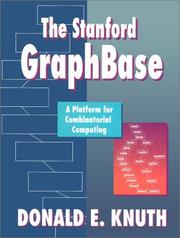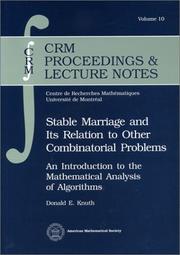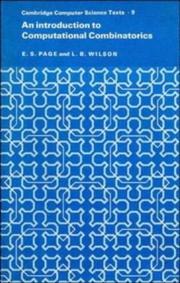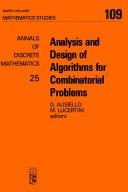| Listing 1 - 9 of 9 |
Sort by
|
Book
ISBN: 0840503423 9780840503428 Year: 1976 Publisher: Montreal: Presses de l'Université de Montréal,
Abstract | Keywords | Export | Availability | Bookmark
 Loading...
Loading...Choose an application
- Reference Manager
- EndNote
- RefWorks (Direct export to RefWorks)

ISBN: 0201542757 0135238250 9780201542752 Year: 1993 Publisher: Reading (Mass.) : Addison-Wesley,
Abstract | Keywords | Export | Availability | Bookmark
 Loading...
Loading...Choose an application
- Reference Manager
- EndNote
- RefWorks (Direct export to RefWorks)
The Stanford GraphBase: A Platform for Combinatorial Computing represents the first fruits of Donald E. Knuth's preparation for Volume 4 of The Art of Computer Programming. The book's first goal is to demonstrate, through about 30 examples, the art of literate programming. Each example is a programmatic essay, a short story that can be read and enjoyed by human beings as readily as it can be read and interpreted by machines. In these essays/programs, Knuth makes new contributions to the exposition of several important algorithms and data structures, so the programs are of special interest for their content as well as for their style. The book's second goal is to provide a useful means for comparing combinatorial algorithms and for evaluating methods of combinatorial computing. To this end, Knuth's programs offer standard freely available sets of data - the Stanford GraphBase - that may be used as benchmarks to test competing methods. The data sets are both interesting in themselves and applicable to a wide variety of problem domains. With objective tests here made possible, Knuth hopes to bridge the gap between theoretical computer scientists and programmers' who have real problems to solve. As with all of Knuth's writings, this book is appreciated not only for the author's unmatched insight, but also for the fun and the challenge of his work, in which he invites us to participate. He illustrates many of the most significant and most beautiful combinatorial algorithms that are presently known and provides demonstration programs that can lead to hours of amusement. In showing how the Stanford GraphBase can generate an almost exhaustible supply of challenging problems, some of which may lead to the discovery of new and improved algorithms, Knuth proposes friendly competitions. His own initial entries into such competitions are included in the book, and readers are challenged to do better.
Combinatorial analysis --- Analyse combinatoire --- Data processing --- Informatique --- Stanford GraphBase --- -Combinatorics --- Algebra --- Mathematical analysis --- Data processing. --- Stanford GraphBase. --- -Data processing --- Stanford Graph base --- GraphBase --- Algoritmos E Estruturas De Dados --- Teoria Dos Grafos --- Combinatorial analysis - Data processing

ISBN: 0821806033 9780821806036 Year: 1997 Volume: 10 Publisher: Providence (R.I.): American mathematical society,
Abstract | Keywords | Export | Availability | Bookmark
 Loading...
Loading...Choose an application
- Reference Manager
- EndNote
- RefWorks (Direct export to RefWorks)
Combinatorial analysis --- Marriage theorem --- Data processing --- Data processing. --- 511.6 --- Algebraic number fields --- 511.6 Algebraic number fields --- Stable marriage problem (Combinatorial analysis) --- Matching theory --- Combinatorial analysis - Data processing --- Marriage theorem - Data processing
Book
ISBN: 0201038595 9780201038590 Year: 1982 Publisher: Reading, Mass.: Addison-Wesley,
Abstract | Keywords | Export | Availability | Bookmark
 Loading...
Loading...Choose an application
- Reference Manager
- EndNote
- RefWorks (Direct export to RefWorks)
Computer science --- Discrete mathematics --- Combinatorial analysis --- Operations research --- Computer algorithms --- Analyse combinatoire --- Algorithmes --- Data processing --- Informatique --- Algorithms --- -Computer algorithms --- -Operational analysis --- Operational research --- Industrial engineering --- Management science --- Research --- System theory --- Combinatorics --- Algebra --- Mathematical analysis --- Computer algorithms. --- Data processing. --- -Data processing --- Combinatorial analysis. --- Algorithms. --- Analyse combinatoire. --- Algorithmes. --- Recherche opérationnelle --- Combinatorial analysis - Data processing --- Operations research - Data processing --- Programmation mathematique --- Programmation dynamique

ISBN: 0521224276 0521294924 9780521224277 9780521294928 Year: 1979 Volume: 9 Publisher: Cambridge [Eng.]: New York: Cambridge university press,
Abstract | Keywords | Export | Availability | Bookmark
 Loading...
Loading...Choose an application
- Reference Manager
- EndNote
- RefWorks (Direct export to RefWorks)
Discrete mathematics --- Combinatorial analysis --- Analyse combinatoire --- Data processing --- Informatique --- 519.1 --- 681.3*G21 --- Combinatorics. Graph theory --- Combinatorics: combinatorial algorithms; counting problems; generating functions; permutations and combinations; recurrences and difference equations --- Data processing. --- 681.3*G21 Combinatorics: combinatorial algorithms; counting problems; generating functions; permutations and combinations; recurrences and difference equations --- 519.1 Combinatorics. Graph theory --- Combinatorial analysis - Data processing
Book
ISBN: 0201509431 Year: 1990 Publisher: Redwood City (Calif.) : Addison-Wesley,
Abstract | Keywords | Export | Availability | Bookmark
 Loading...
Loading...Choose an application
- Reference Manager
- EndNote
- RefWorks (Direct export to RefWorks)
Discrete mathematics --- Mathematica (Computer program) --- Mathematica (Computerprogramma) --- Graph theory --- Mathematica (Computer program language) --- Computer science --- Combinatorial analysis --- Data processing --- Mathematics --- 519.1 --- -Graph theory --- Graphs, Theory of --- Theory of graphs --- Topology --- Combinatorics --- Algebra --- Mathematical analysis --- Combinatorics. Graph theory --- Extremal problems --- Data processing. --- Mathematica (Computer file) --- -Combinatorics. Graph theory --- Mathematica (Computer file). --- 519.1 Combinatorics. Graph theory --- -519.1 Combinatorics. Graph theory --- Combinatorial analysis - Data processing. --- Graph theory - Data processing. --- Mathematics.
Book
ISBN: 0080160913 1322556709 1483186660 9780080160917 Year: 1971 Publisher: Oxford: Pergamon,
Abstract | Keywords | Export | Availability | Bookmark
 Loading...
Loading...Choose an application
- Reference Manager
- EndNote
- RefWorks (Direct export to RefWorks)
Combinatorial analysis --- Analyse combinatoire --- Data processing --- Informatique --- -681.3*D32 --- Combinatorics --- Algebra --- Mathematical analysis --- language classifications: applicative languages; data-flow languages; design languages; extensible languages; macro and assembly languages; nonprocedural languages; specialized application and very high-level languages (Programminglanguages) --- 681.3*D32 language classifications: applicative languages; data-flow languages; design languages; extensible languages; macro and assembly languages; nonprocedural languages; specialized application and very high-level languages (Programminglanguages) --- 681.3*D32 --- Combinatorial analysis - Data processing
Book
ISBN: 013152447X 9780131524477 Year: 1977 Publisher: Englewood Cliffs (N.J.) : Prentice-Hall,
Abstract | Keywords | Export | Availability | Bookmark
 Loading...
Loading...Choose an application
- Reference Manager
- EndNote
- RefWorks (Direct export to RefWorks)
Computer science --- Combinatorial analysis --- Analyse combinatoire --- Data processing --- Informatique --- 519.1 --- 681.3*G --- 681.3*G21 --- -Combinatorics --- Algebra --- Mathematical analysis --- Combinatorics. Graph theory --- Mathematics of computing --- Combinatorics: combinatorial algorithms; counting problems; generating functions; permutations and combinations; recurrences and difference equations --- Data processing. --- -Combinatorics. Graph theory --- 681.3*G21 Combinatorics: combinatorial algorithms; counting problems; generating functions; permutations and combinations; recurrences and difference equations --- 681.3*G Mathematics of computing --- 519.1 Combinatorics. Graph theory --- -681.3*G21 Combinatorics: combinatorial algorithms; counting problems; generating functions; permutations and combinations; recurrences and difference equations --- Combinatorics --- Combinatorial analysis - Data processing

ISBN: 0444876995 9780444876997 9780080872209 0080872204 1281788279 9781281788276 9786611788278 6611788271 Year: 1985 Volume: 25 109 Publisher: Amsterdam ; New York : New York, N.Y., U.S.A. : North-Holland ; Sole distributors for the U.S.A. and Canada, Elsevier Science Pub. Co.,
Abstract | Keywords | Export | Availability | Bookmark
 Loading...
Loading...Choose an application
- Reference Manager
- EndNote
- RefWorks (Direct export to RefWorks)
Combinatorial problems have been from the very beginning part of the history of mathematics. By the Sixties, the main classes of combinatorial problems had been defined. During that decade, a great number of research contributions in graph theory had been produced, which laid the foundations for most of the research in graph optimization in the following years. During the Seventies, a large number of special purpose models were developed. The impressive growth of this field since has been strongly determined by the demand of applications and influenced by the technological increases in compu
Discrete mathematics --- Combinatorial analysis --- Combinatorial number theory. --- Data processing. --- Data processing --- Number theory --- 519.1 --- 681.3*G21 --- 681.3*G22 --- 519.1 Combinatorics. Graph theory --- Combinatorics. Graph theory --- 681.3*G21 Combinatorics: combinatorial algorithms; counting problems; generating functions; permutations and combinations; recurrences and difference equations --- Combinatorics: combinatorial algorithms; counting problems; generating functions; permutations and combinations; recurrences and difference equations --- 681.3*G22 Graph theory: graph algorithms; network problems; path and tree problems; trees--See also {681.3*F22} --- Graph theory: graph algorithms; network problems; path and tree problems; trees--See also {681.3*F22} --- Combinatorial analysis - Data processing
| Listing 1 - 9 of 9 |
Sort by
|

 Search
Search Feedback
Feedback About UniCat
About UniCat  Help
Help News
News